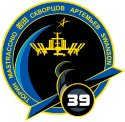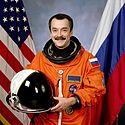Michail Wladislawowitsch Tjurin
| Michail Tjurin | |
|---|---|
 | |
| Land: | Russland |
| Organisation: | Roskosmos |
| ausgewählt am | 1. April 1994 |
| Einsätze: | 3 Raumflüge |
| Start des ersten Raumflugs: | 10. August 2001 |
| Landung des letzten Raumflugs: | 14. Mai 2014 |
| Zeit im Weltraum: | 532d 2h 50min |
| EVA-Einsätze: | 5 |
| EVA-Gesamtdauer: | 25h 32min |
| Raumflüge | |
| |
Michail Wladislawowitsch „Mischa“ Tjurin (russisch Михаил Владиславович Тюрин, wiss. Transliteration Michail Vladislavovič Tjurin; * 2. März 1960 in Kolomna, Russische SFSR) ist ein ehemaliger russischer Kosmonaut.
Tjurin schloss 1984 das Staatliche Luftfahrtinstitut in Moskau, wo er sich auf die Erstellung mathematischer Modelle spezialisiert hatte, mit einem Ingenieursdiplom als Flugzeugmechaniker ab. Der russische Raumfahrtkonzern RKK Energija beschäftigte ihn anschließend als Ingenieur im Bereich Kosmonautenausbildung. Dort war er damit beauftragt, das Training bei Abläufen im Sojus-Raumschiff effizienter zu gestalten. Daneben arbeitete er an Computerprogrammen.
Kosmonautentätigkeit
Im April 1994 wurde Tjurin für das Kosmonautenkorps ausgewählt. Die nächsten drei Jahre absolvierte er im „Sternenstädtchen“ die Grundausbildung und wurde dann für seinen ersten Raumflug aufgestellt: ab Sommer 1997 trainierte er als Bordingenieur für die Ersatzmannschaft der Expedition 1 auf der Internationalen Raumstation (ISS) und anschließend für die Flugbesatzung der übernächsten Langzeitcrew.
Gemeinsam mit Frank Culbertson und Wladimir Deschurow bildete Tjurin die ISS-Expedition 3, die im August 2001 zur Raumstation starteten. Als Zubringer fungierte die Space-Shuttle-Mission STS-105, die bei ihrem Rückflug die abgelöste ISS-Expedition 2 zurück zur Erde brachte. Culbertson, Tjurin und Deschurow arbeiteten vier Monate auf der ISS und wurden mit STS-108 abgeholt.
Ab Dezember 2003 bereitete sich Tjurin für künftige Langzeitmannschaften der Raumstation vor. Zunächst in der „zweiten Reihe“ als Mitglied von Ersatzbesatzungen (Kommandant von ISS-Expedition 11, Bordingenieur von ISS-Expedition 12), wurde er schließlich für die Hauptmannschaft der 14. Stammbesatzung ausgewählt.
Tjurin war Bordingenieur der ISS-Expedition 14, die am 18. September 2006 mit Sojus TMA-9 startete und am 21. April 2007 landete.
Zu seinem dritten Raumflug startete er am 7. November 2013 als Kommandant von Sojus TMA-11M. Als Mitglied der ISS-Expeditionenen 38 und 39 arbeitete er von November 2013 bis Mai 2014 als Bordingenieur auf der ISS.
Im Januar 2016 schied er aus dem Kosmautenteam aus.
Siehe auch
Weblinks
- Biografie von Michail Wladislawowitsch Tjurin beim Juri-Gagarin-Kosmonautentrainingszentrum (russisch)
- Kurzbiografie von Michail Wladislawowitsch Tjurin bei spacefacts.de
- Biografie von Michail Wladislawowitsch Tjurin in der Encyclopedia Astronautica (englisch)
| Personendaten | |
|---|---|
| NAME | Tjurin, Michail Wladislawowitsch |
| ALTERNATIVNAMEN | Михаил Владиславович Тюрин |
| KURZBESCHREIBUNG | russischer Kosmonaut |
| GEBURTSDATUM | 2. März 1960 |
| GEBURTSORT | Kolomna, Russische SFSR |
Auf dieser Seite verwendete Medien
Soyuz TMA-11M crew patch.
Like Tyurin's earlier Soyuz TMA-9 patch, this design features the MAI 6th logo — the faculty of the Moscow Aviation Institute that he graduated from. Also pictured is an Olympic flame, for this flight will deliver to the ISS the Sochi 2014 torch.
A. Panchenko:
"Simple design of Soyuz TMA-9 patch includes the following elements: the docking target on the ISS to which the Soyuz will align itself, element of symbol of 6th Faculty of MAI, which graduated by Soyuz TMA-9 pilot-commander Mikhail Tyurin, three cosmic stars according three Soyuz flight Team members (M. Tyurin, M. Lopez-Alegria both ISS-14 crew and
ISS Expedition 38 Patch
As the International Space Station (ISS) has become a stepping stone to future space exploration, the Expedition 38 mission patch design paints a visual roadmap of exploration beyond low Earth orbit, most prominently represented by the design's flowing Expedition 38 mission numbers that wrap around Earth, the moon and Mars. Just as the sun is a guiding light in the galaxy, the ISS illuminates the bottom of the design as it is a shining beacon of the advancement of science, knowledge, and technology carried out aboard the Space Station. To visually capture the idea of the ISS being a foundation for infinite discovery, the space station's iconic solar arrays span upwards, providing the number 38 and its exploration roadmap a symbolic pedestal to rest on. Finally, the overall use of red, white, and blue in the design acknowledges the flags of the countries of origin for Expedition 38's crew -- the United States, Russia, and Japan.
ISS Expedition 39 Patch
Increment 39 of the International Space Station Program marks the 15th year of operation since the start of the space laboratory assembly. Today, the U.S., Russia, Japan, Canada and the European Space Agency are partnering in the operation of the largest ever orbital outpost managed by humankind. The names of the six crew members are depicted in their native languages. For Expedition 39, the Soyuz spacecraft serves as transport vehicle for the crew members to and from the station. During this expedition, the ISS will serve as a platform for scientific research, Earth and astronomical observation, education, as well as a stage for the development of new technologies used for the exploration beyond low Earth orbit. The star above the complex signifies human space exploration towards new frontiers. The crew members added these words: "The crew of Expedition 39 is proud to serve the international community in furthering our scientific knowledge and in expanding human presence in space."
The STS-105 crew patch symbolizes the exchange of the Expedition Two and Expedition Three crews aboard the International Space Station. The three gold stars near the ascending Orbiter represent the U.S. commanded Expedition Three crew as they journey into space, while the two gold stars near the descending Orbiter represent the Russian commanded Expedition Two crew and their return to Earth. The plumes of each Orbiter represent the flags of the United States and Russia and symbolize the close cooperation between the two countries. The Astronaut Office symbol, a star with three rays of light, depicts the unbroken link between Earth and the newest and brightest star on the horizon, the International Space Station (ISS). The ascending and descending Orbiters form a circle that represents both the crew rotation and the continuous presence in space aboard the ISS. The names of the four astronauts who will crew Discovery are shown along the border of the patch. The names of the Expedition Three and Expedition Two crews are shown on the chevron at the bottom of the patch. The NASA insignia design for Shuttle flights is reserved for use by the astronauts and for other official use as the NASA Administrator may authorize. Public availability has been approved only in the form of illustrations by the various news media. When and if there is any change in this policy, which we do not anticipate, it will be publicly announced.
Cosmonaut Mikhail Tyurin representing Russia's Federal Space Agency
ISS Expedition 3 Mission patch
It depicts the book of space history, turning from the chapter with the Russian space station Mir and the space shuttle to the next chapter, one that will be written on the blank pages of the future by space explorers working for the benefit of the entire world. Above the book is a layout of what the station will look like when completed, docked with the space shuttle. The Expedition Three crew members – astronaut Frank L. Culbertson, Jr., commander, and cosmonauts Vladimir N. Dezhurov and Mikhail Tyurin, flight engineers – had the following to say about the insignia for their scheduled mission aboard the International Space Station (ISS): “The book of space history turns from the chapter written onboard the Russian Mir Station and the U.S. Space Shuttle to the next new chapter, one that will be written on the blank pages of the future by space explorers working for the benefit of the entire world. The space walker signifies the human element of this endeavor. The star representing the members of the third expedition, and the entire multi-national Space Station building team, streaks into the dawning era of cooperative space exploration, represented by the image of the International Space Station as it nears completion.”
This emblem embodies the past, present, and future of human space exploration. The Roman numeral XIV suspended above the Earth against the black background of space symbolizes the fourteenth expeditionary mission to the International Space Station (ISS), or Международная Космическая Станция. Elements of this symbol merge into a unified trajectory destined for the moon, Mars, and beyond, much as science and operations aboard the ISS today will pave the way for future missions to our celestial neighbors. The five stars honor the astronauts and cosmonauts of missions Apollo 1, Soyuz 1, Soyuz 11, Challenger, and Columbia, who gave their lives in the pursuit of knowledge and discovery.







